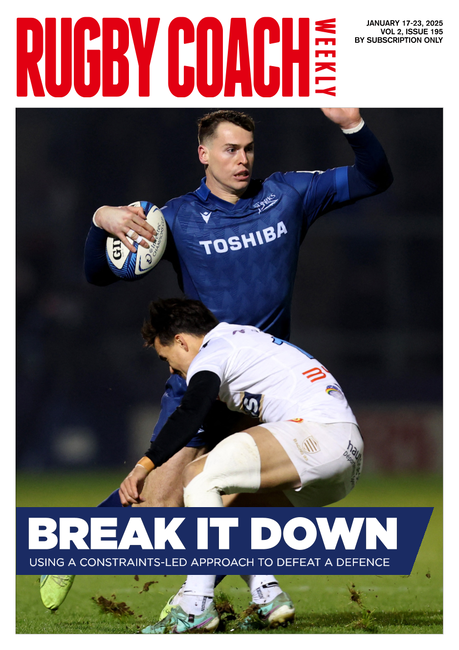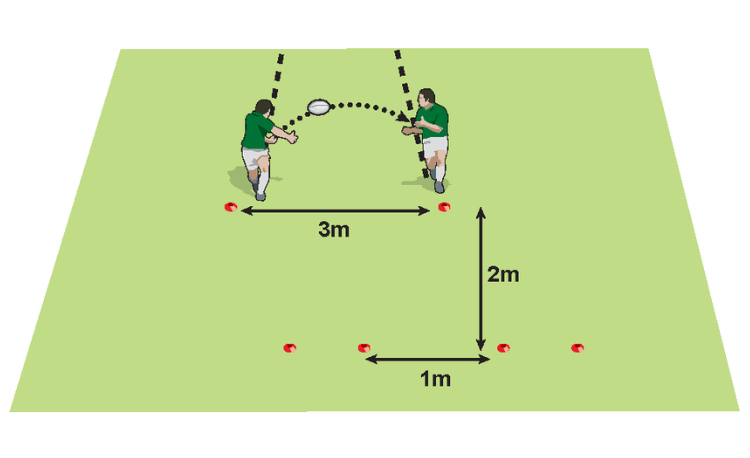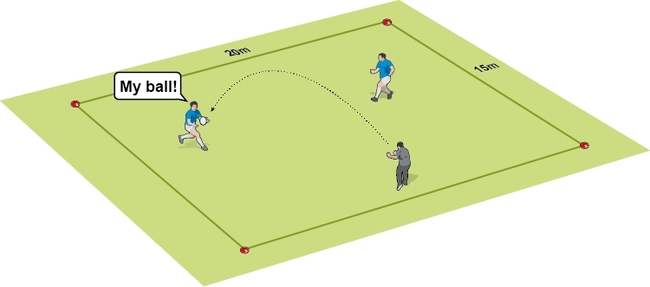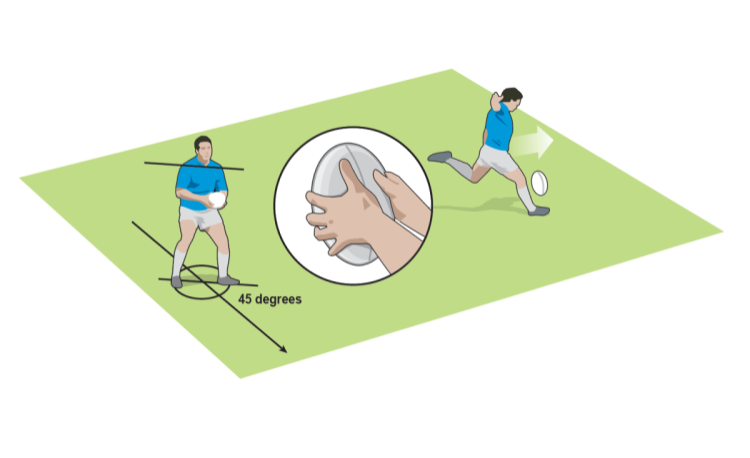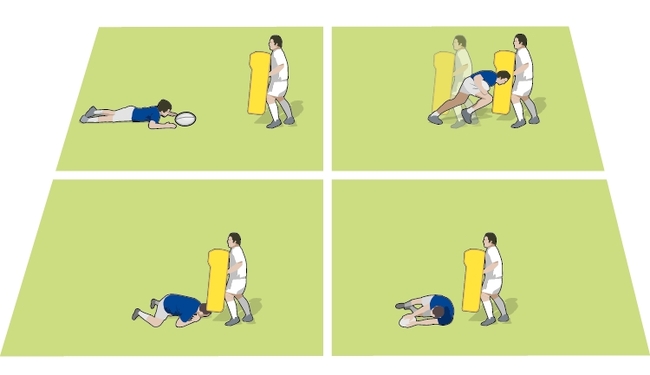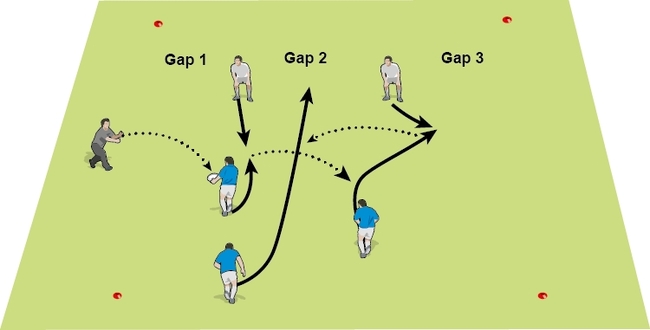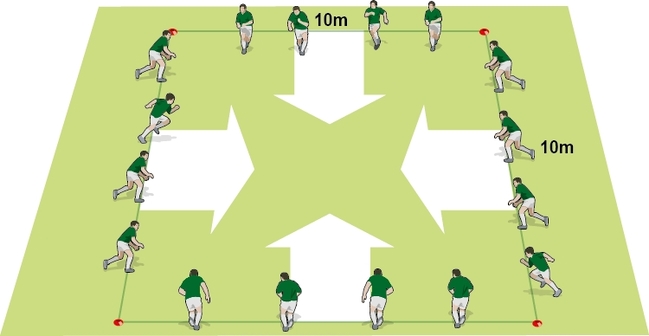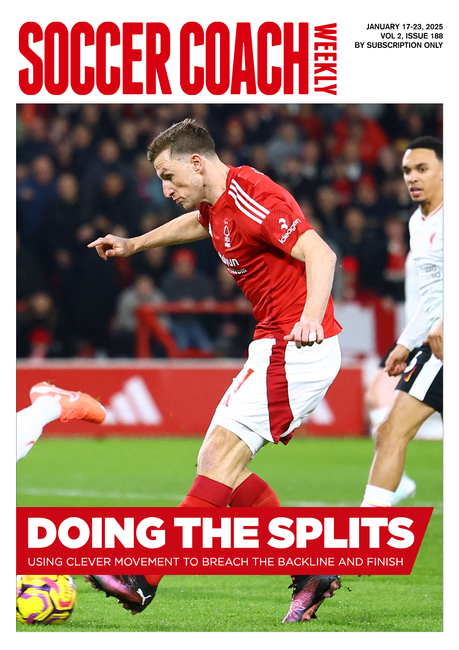Aerial noughts and crosses
Kicking & Catchingby Tom Brocklebank
Improve your kicking with a game of aerial noughts and crosses. Teams take it in turns to kick the ball and aim to drop it in a square which marks their nought or cross.
Aerial noughts and crosses gives your players a chance to make accurate kicks with additional tactical pressures as you build the game.
The aim is always to create a line of three "Xs", with various constraints on how this is achieved.
I like to start with 1v1, with one player in each area. However, you will need to adapt the playing area and the numbers depending on your teams.
You could then have around four games of noughts and crosses being played on a pitch, while other players in your squad can be practising their kicking in dead ball areas or doing another activity while noughts and crosses is going on.
I allow any kind of kick. You can encourage certain players to use specific ones depending on their individual ‘work-ons’. For example, you may have a full-back who you want to practise high up-and-unders so you ban low kicks, or you may have a scrum half who you want to be more aware of chips just over the defensive line so you can encourage the other team to play quickly with low chips.
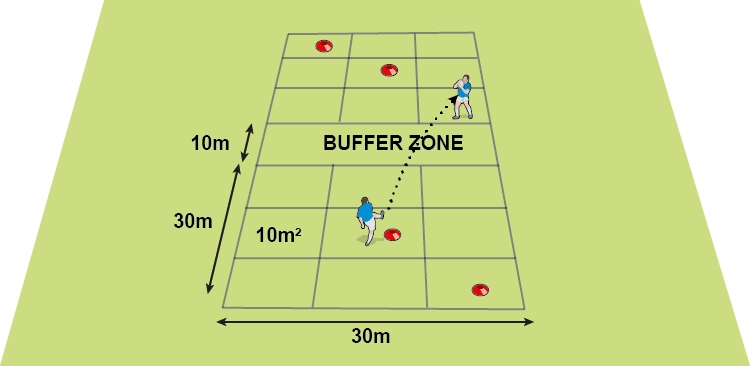
Divide two areas into 9 squares. How large you make your areas and squares is up to you and your team, I usually start off with two 30m square areas with a 10m “buffer-zone” between them, therefore each square of each area will be a 10m square.
Start with one player in each grid and they can start where they like.
Team A kicks to Team B, aiming for their chosen square.
To start with, place a bib or cone in the square the ball was landing in, regardless of whether it landed, was caught or missed. This helps to build confidence and makes the focus purely on the kick as it ignores the fielding of the kick.
Swap, so Team B then kick to Team A with the same success outcome.
Repeat until a team has three bibs in a straight line.
You may need to make the areas and squares larger, or extend the buffer-zone between the areas for this.
Again, with one player in each grid.
Team A kicks to Team B, aiming for their chosen square.
This time a square is only marked if the ball lands, is dropped or missed in a square. Therefore if Team B manage to catch it, no square is marked.
Swap, so Team B kick to Team A.
Repeat until a team has three bibs in a straight line, this is the winning team.
Add in an extra player on each team. Leave it up to the players how they use them or where they’re placed.
Some choose to use the extra man to chase the kick, in which case you can mark a nought or cross if they manage to catch their team’s kick as well as it landing or being dropped by the opposition.
Others like to keep both players back to account for quick, low kicks allowing them to cover more of their area.
One player from Team A kicks to Team B, Team A’s second player can chase the kick to try and apply pressure or catch the ball.
If the ball lands, is dropped or missed by Team B, or is caught by Team A’s chaser, mark a bib in the square the ball was landing in with a bib for Team A.
Swap, so Team B kick to Team A.
Repeat until a team has three bibs in a straight line to win the game.
Make sure to have balls ready so each team can take their kick as quick as they like or in case of small bits of gamesmanship like a chasing players holding the ball or not letting the opposition take their kick quickly, or you may want to slow them down to let both sides set.
As a bit of fun you could play full pitch with either half divided into 9 with the two 10m lines creating a 20m buffer zone.
As you’ll likely be playing with more players, encourage the players to find ways of making catching their kicks difficult.
Most will resort to kicking as high as possible, however encourage exploration around kicking the ball at different heights, trajectories, parts of their foot, angles of the ball and spin.
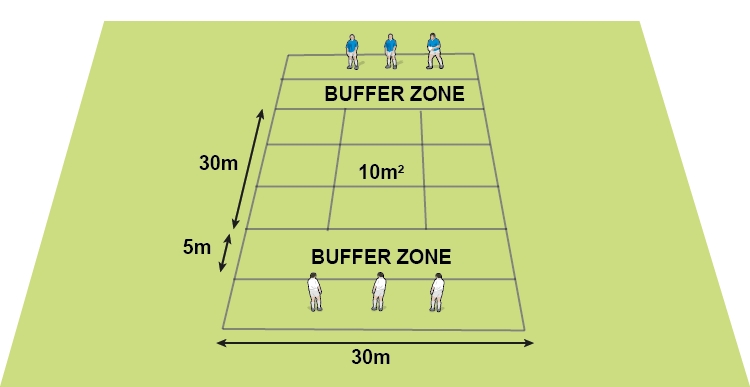
You can modify any of the above games to play with one grid in between the two teams, and play with the same rules as each game.
This time they will be trying to avoid any bibs placed by other teams, making the game more difficult and requiring more accuracy on the kick:
The kicking team starts in their area, distanced by a 10m buffer zone. The receiving team will move into the grid between them to attempt to catch the ball.
Play the same rules as the above games.
Aerial noughts and crosses gives your players a chance to make accurate kicks with additional tactical pressures as you build the game.
The aim is always to create a line of three "Xs", with various constraints on how this is achieved.
HOW TO BUILD THE SESSION
I like to start with 1v1, with one player in each area. However, you will need to adapt the playing area and the numbers depending on your teams.
You could then have around four games of noughts and crosses being played on a pitch, while other players in your squad can be practising their kicking in dead ball areas or doing another activity while noughts and crosses is going on.
I allow any kind of kick. You can encourage certain players to use specific ones depending on their individual ‘work-ons’. For example, you may have a full-back who you want to practise high up-and-unders so you ban low kicks, or you may have a scrum half who you want to be more aware of chips just over the defensive line so you can encourage the other team to play quickly with low chips.
Game 1

Divide two areas into 9 squares. How large you make your areas and squares is up to you and your team, I usually start off with two 30m square areas with a 10m “buffer-zone” between them, therefore each square of each area will be a 10m square.
Start with one player in each grid and they can start where they like.
Team A kicks to Team B, aiming for their chosen square.
To start with, place a bib or cone in the square the ball was landing in, regardless of whether it landed, was caught or missed. This helps to build confidence and makes the focus purely on the kick as it ignores the fielding of the kick.
Swap, so Team B then kick to Team A with the same success outcome.
Repeat until a team has three bibs in a straight line.
Game 2
You may need to make the areas and squares larger, or extend the buffer-zone between the areas for this.
Again, with one player in each grid.
Team A kicks to Team B, aiming for their chosen square.
This time a square is only marked if the ball lands, is dropped or missed in a square. Therefore if Team B manage to catch it, no square is marked.
Swap, so Team B kick to Team A.
Repeat until a team has three bibs in a straight line, this is the winning team.
Game 3
Add in an extra player on each team. Leave it up to the players how they use them or where they’re placed.
Some choose to use the extra man to chase the kick, in which case you can mark a nought or cross if they manage to catch their team’s kick as well as it landing or being dropped by the opposition.
Others like to keep both players back to account for quick, low kicks allowing them to cover more of their area.
One player from Team A kicks to Team B, Team A’s second player can chase the kick to try and apply pressure or catch the ball.
If the ball lands, is dropped or missed by Team B, or is caught by Team A’s chaser, mark a bib in the square the ball was landing in with a bib for Team A.
Swap, so Team B kick to Team A.
Repeat until a team has three bibs in a straight line to win the game.
Make sure to have balls ready so each team can take their kick as quick as they like or in case of small bits of gamesmanship like a chasing players holding the ball or not letting the opposition take their kick quickly, or you may want to slow them down to let both sides set.
Game 4
As a bit of fun you could play full pitch with either half divided into 9 with the two 10m lines creating a 20m buffer zone.
As you’ll likely be playing with more players, encourage the players to find ways of making catching their kicks difficult.
Most will resort to kicking as high as possible, however encourage exploration around kicking the ball at different heights, trajectories, parts of their foot, angles of the ball and spin.
One grid game

You can modify any of the above games to play with one grid in between the two teams, and play with the same rules as each game.
This time they will be trying to avoid any bibs placed by other teams, making the game more difficult and requiring more accuracy on the kick:
The kicking team starts in their area, distanced by a 10m buffer zone. The receiving team will move into the grid between them to attempt to catch the ball.
Play the same rules as the above games.
Newsletter Sign Up
Coaches Testimonials

Gerald Kearney, Downtown Las Vegas Soccer Club

Paul Butler, Florida, USA

Rick Shields, Springboro, USA

Tony Green, Pierrefonds Titans, Quebec, Canada
Subscribe Today
Be a more effective, more successful rugby coach
In a recent survey 89% of subscribers said Rugby Coach Weekly makes them more confident, 91% said Rugby Coach Weekly makes them a more effective coach and 93% said Rugby Coach Weekly makes them more inspired.
Get Weekly Inspiration
All the latest techniques and approaches
Rugby Coach Weekly offers proven and easy to use rugby drills, coaching sessions, practice plans, small-sided games, warm-ups, training tips and advice.
We've been at the cutting edge of rugby coaching since we launched in 2005, creating resources for the grassroots youth coach, following best practice from around the world and insights from the professional game.

